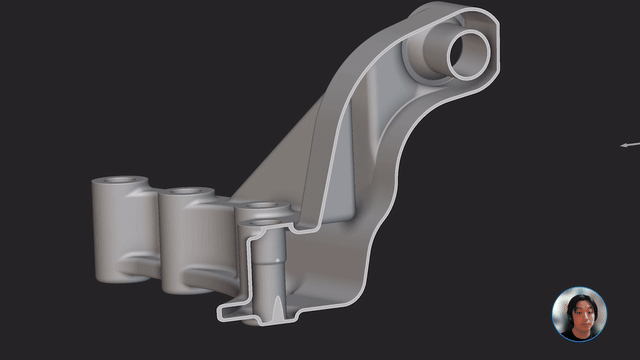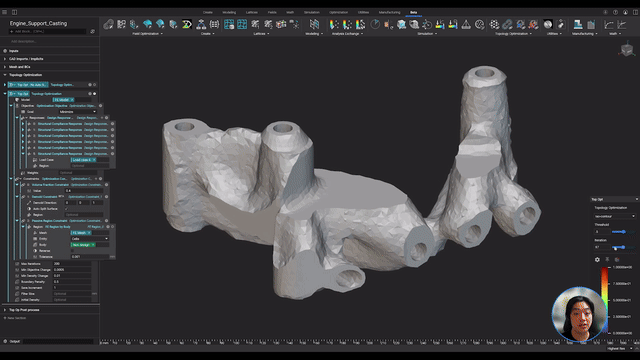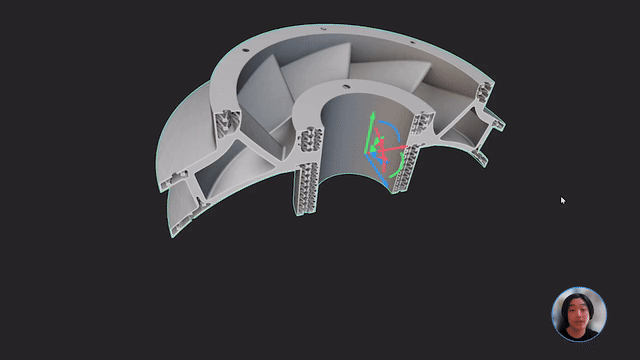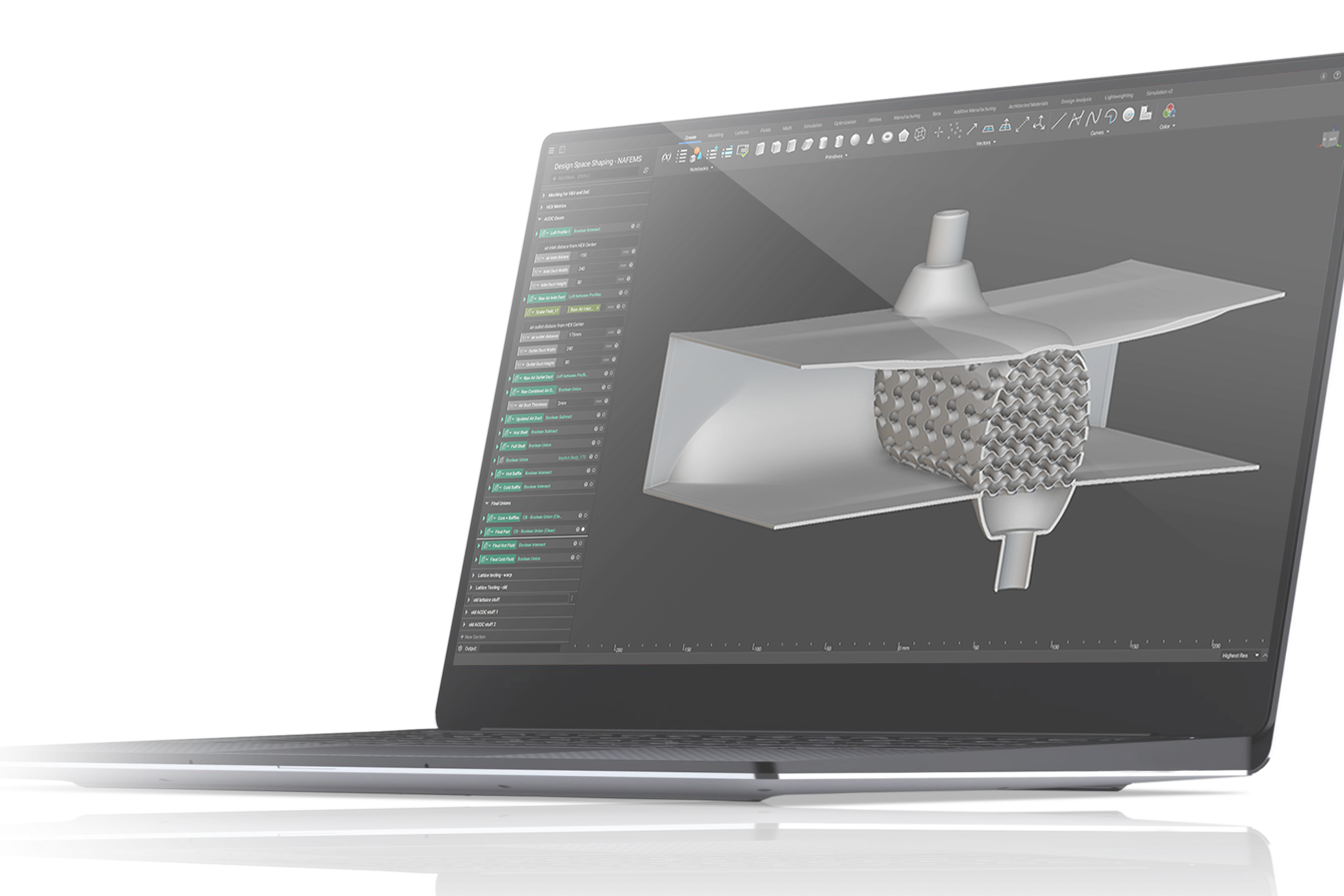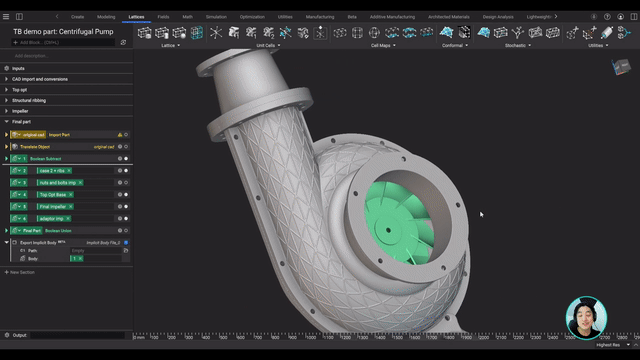5 techniques for lightweighting: Doing more with less
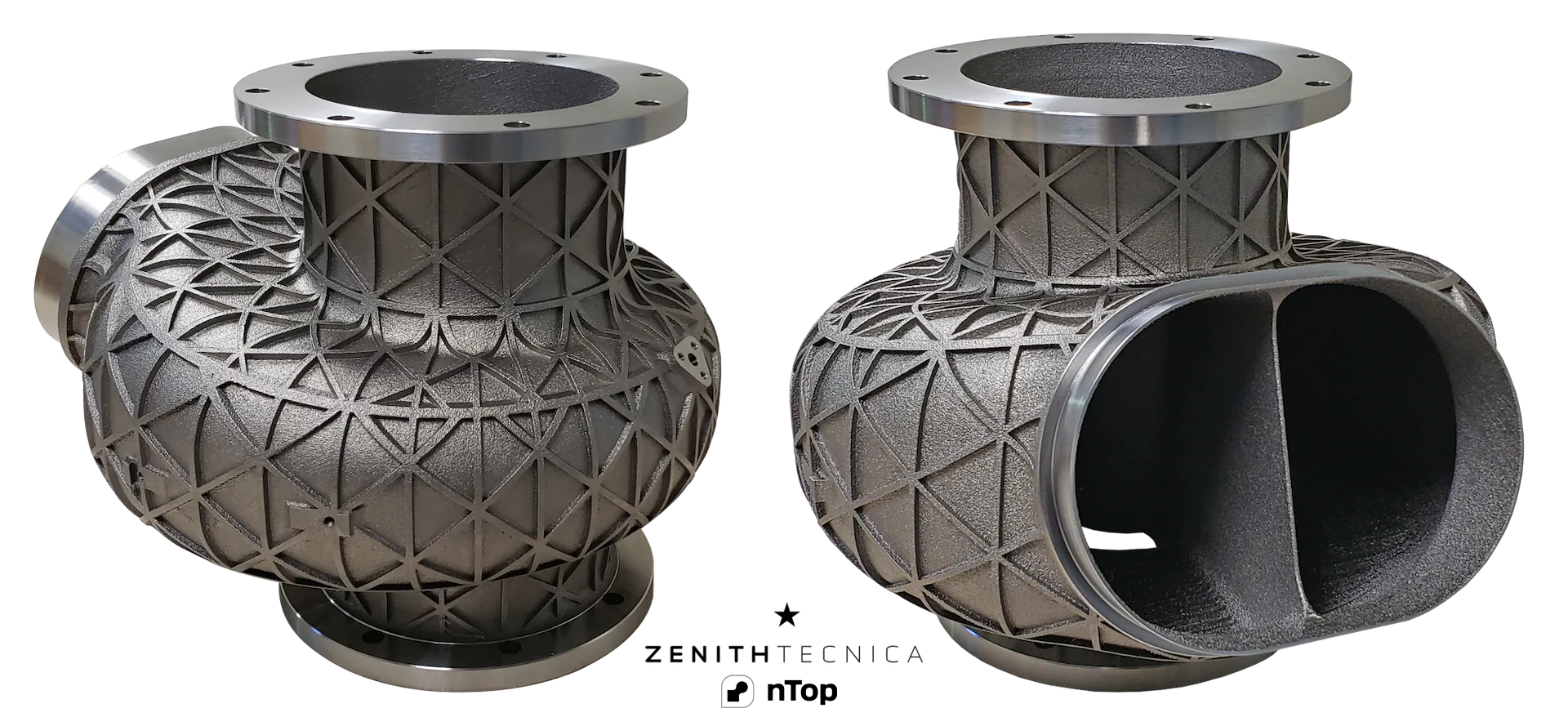
Written by nTop
Published on October 18, 2019
Everyone wants lighter parts, be it for quicker cars, cheaper air travel, or simply bragging rights at your next group bike ride. But it's often difficult to know where to start, with the endless combinations of materials, processes, and design tools available today. Here's a list of 5 techniques to get you started.
So you’re convinced to put your parts on a diet. Or maybe you’re starting from a blank sheet and want to design with lightweighting strategies from the start. The following are five approaches to lightweighting. This is not an exhaustive list or an instruction manual by any means, but some themes to get you started.
The goal of lightweighting
Before we start, let’s first clarify our objective in lightweighting: the word optimize is sometimes used loosely and can lead us astray. It’s better to think of these approaches as steps towards an optimum, and recognize that achieving total optimality is a climb up an asymptotic mountain. How far you choose to climb depends on how much a pound costs to your design. Extra baggage on the way to orbit costs a lot more than on your average road trip.
1. Materials selection
To get started, you need to select the right material. Why use steel if you can get away with aluminum? There’s a weight reduction of approximately two thirds on the table, albeit with compromises: reduced stiffness, higher cost, more difficulty in welding. A great way of visualizing these tradeoffs and rankings of mechanical properties is with Ashby Charts, which essentially represent the menu of materials that an engineer can select from (though more on that later).
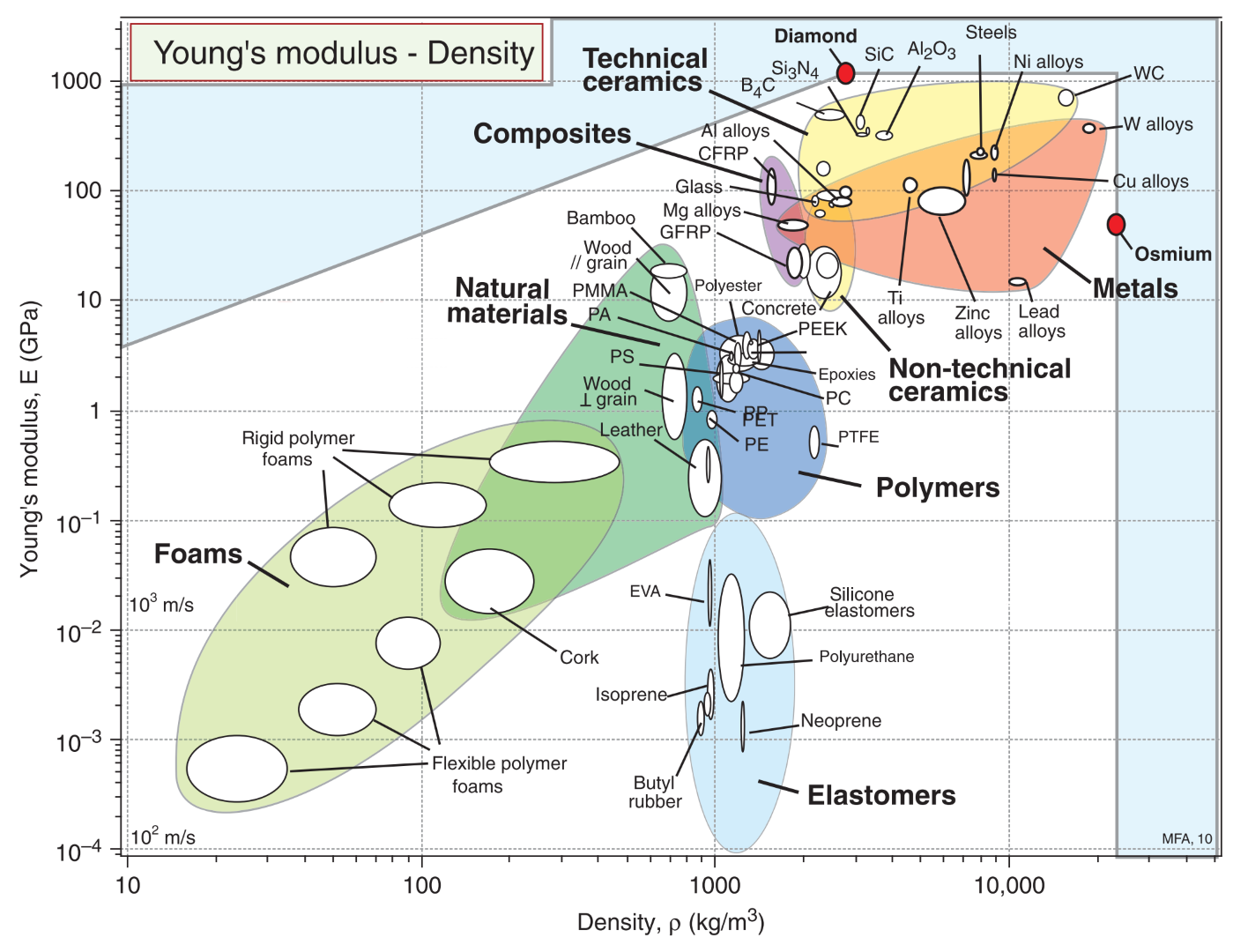
Ashby Chart for evaluating stiffness-to-weight ratio of conventional materials. This essentially represents the menu of (conventional) materials that engineers have to choose from.
These charts can compare any combination of properties, the one shown above being useful for evaluating stiffness-to-weight ratio. Note the logarithmic scale; serious lightweighting can occur just through proper material selection. Our menu of (conventional) materials varies over factors of millions in modulus, and thousands in density. Surely some opportunity for lightweighting lies somewhere in between.
2. Part (or function) consolidation
Material on its own is just feedstock. Only with shape comes a structure or a part. But even using the best material can result in an overweight part if the form does not fit the function. Many assemblies are designed as such due to manufacturing rules, fastened together with nuts and bolts. These alone can add up significantly in weight, not to mention assembly time. Approaching these problems from a function-first mindset, without the shackles of traditional manufacturing rules, can be used to trim a lot of the excess which is not directly contributing to the overall function. The bulky flanges and bolts in this pipe system, for example, don’t help us at all with controlling fluid flow (ie. why we’re even building a part). Why try optimizing something which shouldn’t even exist in the first place?
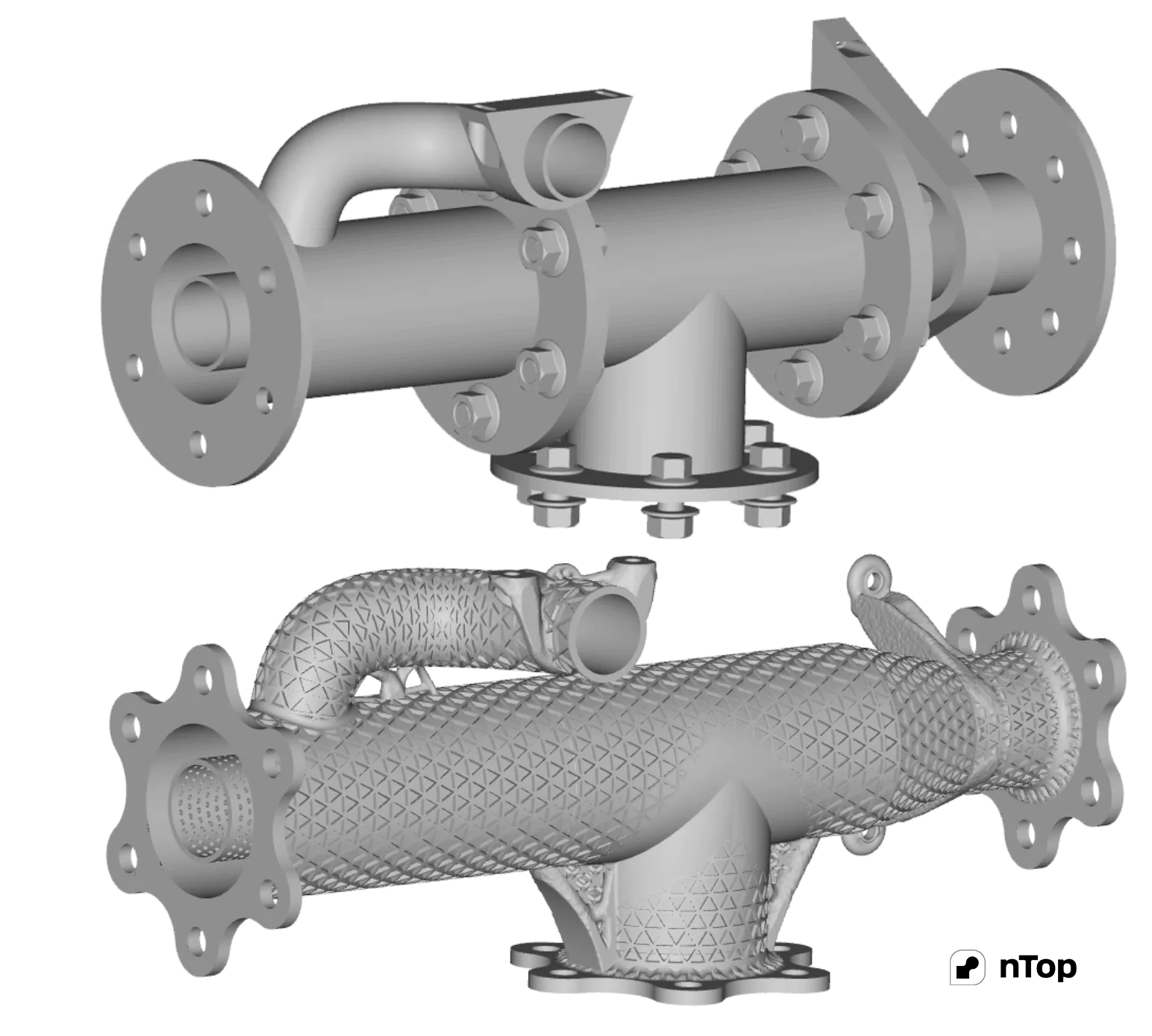
A pipe assembly lightweighted through part-consolidation and conformal ribbing.
3. Conformal ribbing
Conformal ribbing is one of the more popular methods on this list and is very prevalent in aerospace. Whether built from polymers, metals, or composites, conformal ribbing aims to enable thinner walls while improving buckling resistance (otherwise you’re left with a crumpled soda can).

Conformal ribbing on a turbopump casing, produced with electron beam melting (EBM) by Zenith Tecnica.
For polymers, it can be very affordable and easily mass-produced. Look underneath a plastic shipping palette or fold-out table, for example, or even the side of a milk crate. You will find conformal ribbing, which engineers use to lightweight (and reduce material usage) in these relatively simple structures.
But what can we do with stiffer and stronger materials? Isogrid, shown below, has long been popular in the space industry, with design handbooks dating back to the 1970s. They are very expensive to produce via conventional machining: the cost-per-pound for machined metal isogrid is likely only justifiable for high-end aerospace applications, but additive manufacturing is making this technique much more accessible.
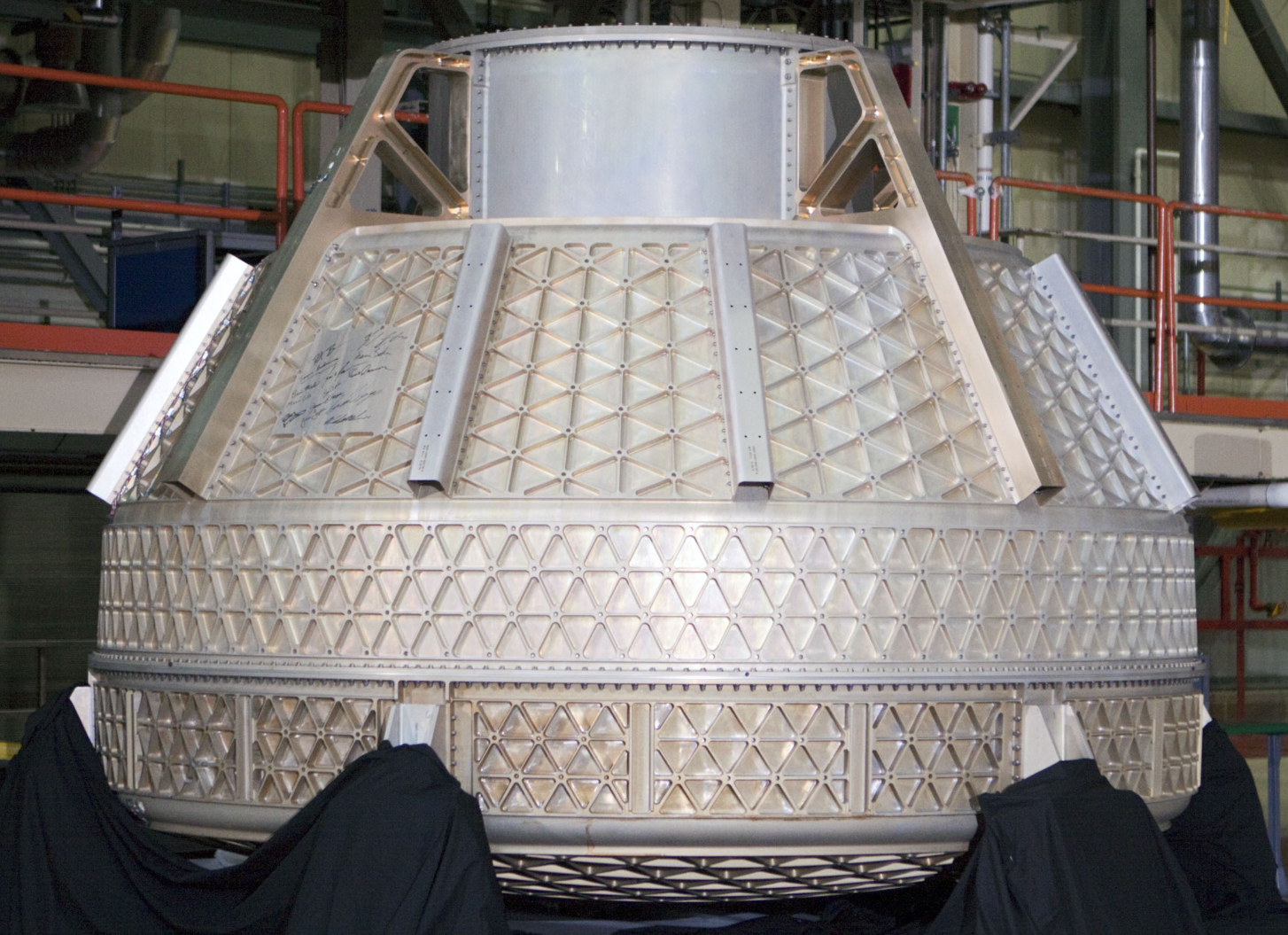
Machined metal isogrid on a spacecraft capsule. The high cost to get vehicles to orbit motivates advanced lightweighting techniques.
4. Lattices and architected materials
Lattices, cellular materials, periodic structures, architected materials… are as diverse as the assortment of names used to describe them. Fundamentally, they are hybrids of solid material and empty space (or gas) -- with the precise arrangement dictating the effective mechanical properties. The amount of material is of course important as well and is referred to as relative density (the mass of the lattice divided by the mass of a solid block of its parent material).
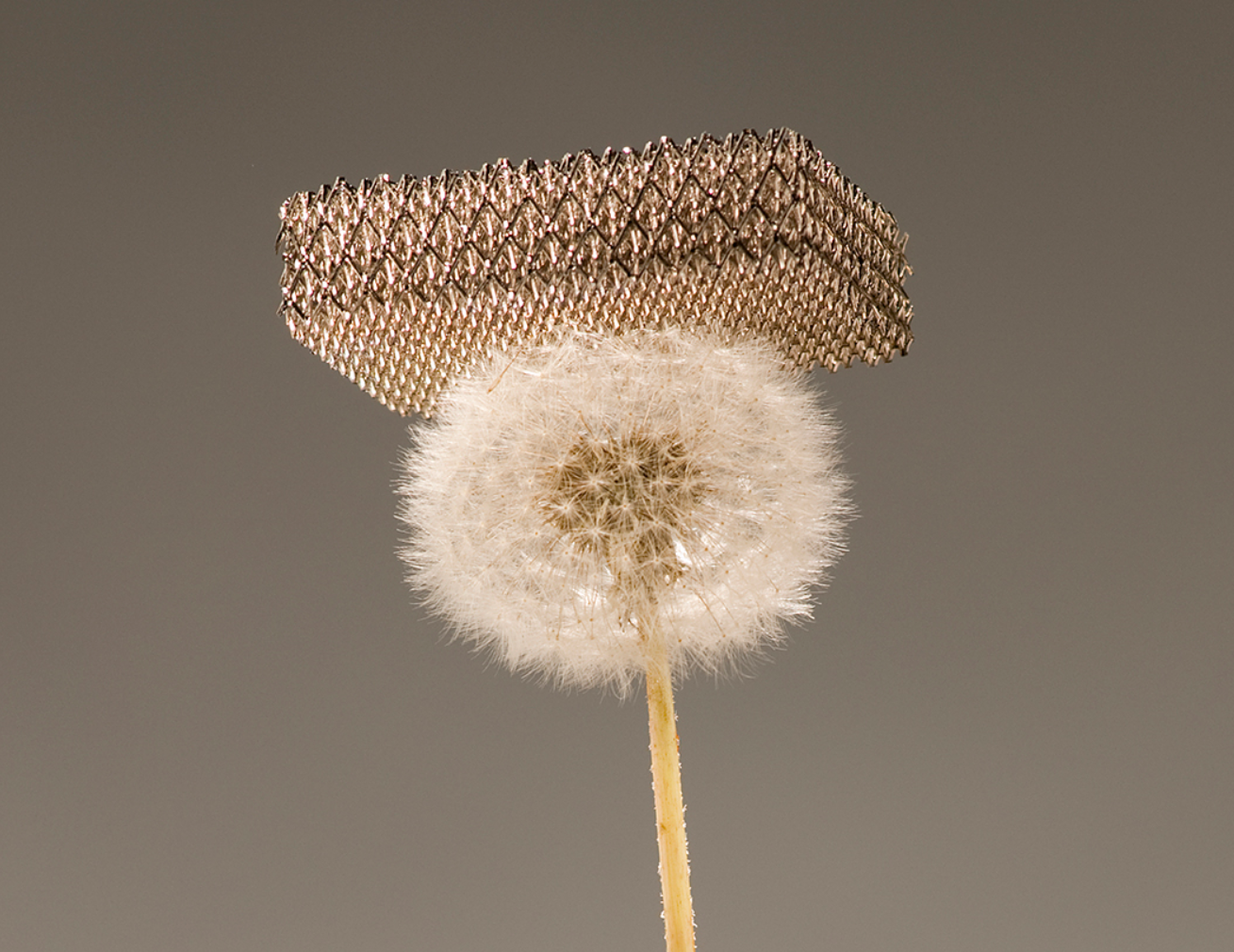
The most extreme example of lightweighting on this list: a nickel microlattice structure fabricated by HRL, with a density 100 times less than styrofoam. Each strut is a hollow nickel tube of approximately 100 nm wall thickness, manufactured through a combination of additive manufacturing and electroless plating.
Some typical suspects in the cellular world include honeycombs, foams, lattices, and shell-like continuous structures such as gyroids, each having its own pros and cons. They can also each be employed in a variety of ways: uniformly as shown below, as an infill of a shelled part, conformally over a surface, or spatially-varying within a complex domain (more on this another time).
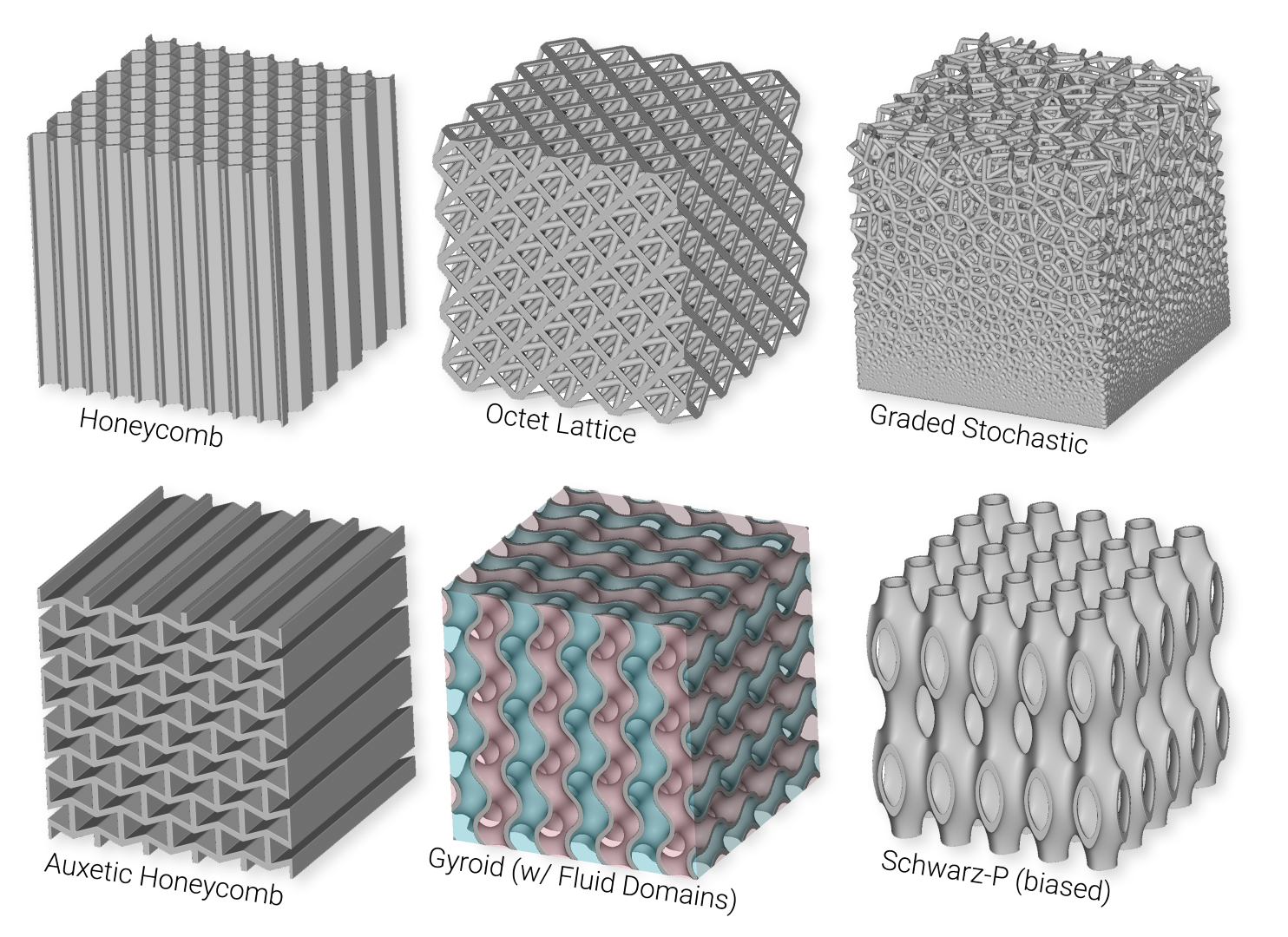
An assortment of the many topologies available for lightweighting, with brief descriptions below.
- Honeycombs are hard to beat in the stiffness-to-weight ratio in their extruded direction but are much softer in the other two orthogonal directions (by around an order of magnitude).
- Octet lattices are stiff in all three principal directions but more difficult to manufacture.
- Stochastic foams are much more compliant but the easiest to finely tailor to a design’s functional requirements through cell size and relative density.
- Auxetic honeycombs can be designed to exhibit special properties like a negative Poisson’s ratio (contracts inwards when compressed, instead of barreling outwards).
- The gyroid and broader family of triply periodic structures inherently have two sides or fluid domains to them, making them natural candidates for heat exchanger applications. They can be easily tailored or biased in different directions to alter stiffness or flow properties as needed.
Cellular materials are perhaps most applicable to engineering in the form of sandwich structures. These are prevalent throughout all levels of the lightweighting value spectrum, from cardboard packaging to commercial aircraft to interplanetary spacecraft. The effect is all the same: separate two thin sheets of material (the bread) by a lightweight core (the filling, available in the flavors shown above) and you can attain tremendous strength and stiffness increases for a minor increase in mass. Turn this around by keeping strength and stiffness constant, and you have significant lightweighting potential.

Bending stiffness and strength benefits of lightweighting with sandwich structures, with a few examples shown.
5. Topology optimization
Last stop for today: topology optimization. Some refer to this as ‘generative design’, but we’ll stick to the engineering term here. Several methods and algorithms exist, but the general idea is to apply loads and restraints to a design region, and then whittle away material from this region until some constraints and objectives are met. At the barebones level, this is usually minimizing compliance (or maximizing stiffness) subject to a volume target. Many cases require additional constraints like maximum stress or displacement, or some restriction on manufacturing technique. The result is usually something exotic and organic looking, which perhaps adds to its allure.
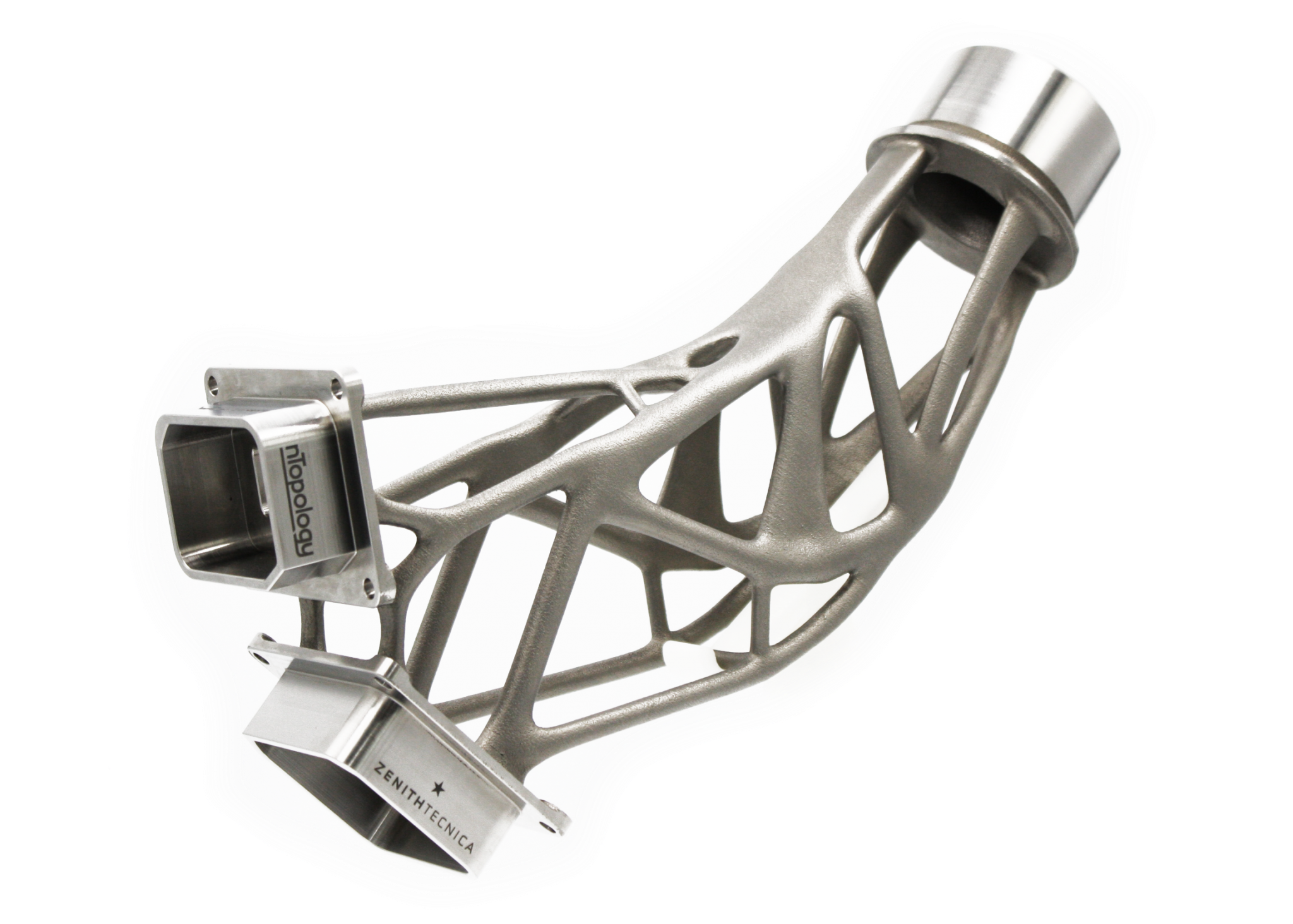
A titanium spacecraft bracket, lightweighted with topology optimization and built with electron beam melting (EBM).
While seemingly hands-off, this approach is far from it. Some steps of it deserve automation, like reconstructing native geometry from the resultant density field or mesh. But users must take extra care in setting up their problems appropriately and understanding the assumptions behind the algorithms which they wield. One common oversight is that many simple codes neglect buckling; consider the very long, thin, slender ligaments seen in many ‘generative design’ examples, and how these would behave when they run over a bump on the road. Likely suboptimally.
How about if those loads are applied off-angle? Uncertainty quantification and ‘design for robustness’ techniques are being developed for this now. This is less specific to topology optimization methods, but relevant to lightweight design in general: as you get closer and closer to the optimum, the result is only as appropriate as the design assumptions.
Key takeaways
Hopefully, this has got you thinking about where you can cut weight from your parts, through one or several of the approaches described above: care in material selection, consolidating parts by their functions to eliminate fasteners and redundancy, conformal ribbing for stiffening, multifunctional design with lattices and architected materials, or through topology optimization to make it lightweight and look great simultaneously. The value of a pound here and there can add up significantly: the thousands of dollars per pound for spacecraft applications makes the combination of all of these methods often justifiable.
Lightweighting is especially important to automotive. Higher performance, better fuel economy, better safety, lower emissions, and the compounding coupling effect that these all have on one another are motivating manufacturers to take their lightweighting efforts to new heights.
Want to learn more about lightweighting in automotive? Watch this nTop Live: Automotive Lightweighting beyond Topology Optimization.

nTop
nTop (formerly nTopology) was founded in 2015 with the belief that engineers’ ability to innovate shouldn’t be limited by their design software. Built on proprietary technologies that upend the constraints of traditional CAD software while integrating seamlessly into existing processes, nTop allows designers in every industry to create complex geometries, optimize instantaneously, and automate workflows to develop breakthrough 3D-printed parts in record time.
